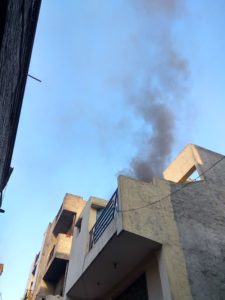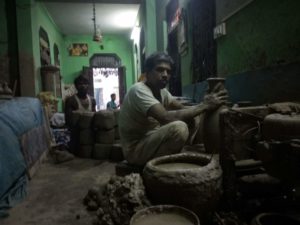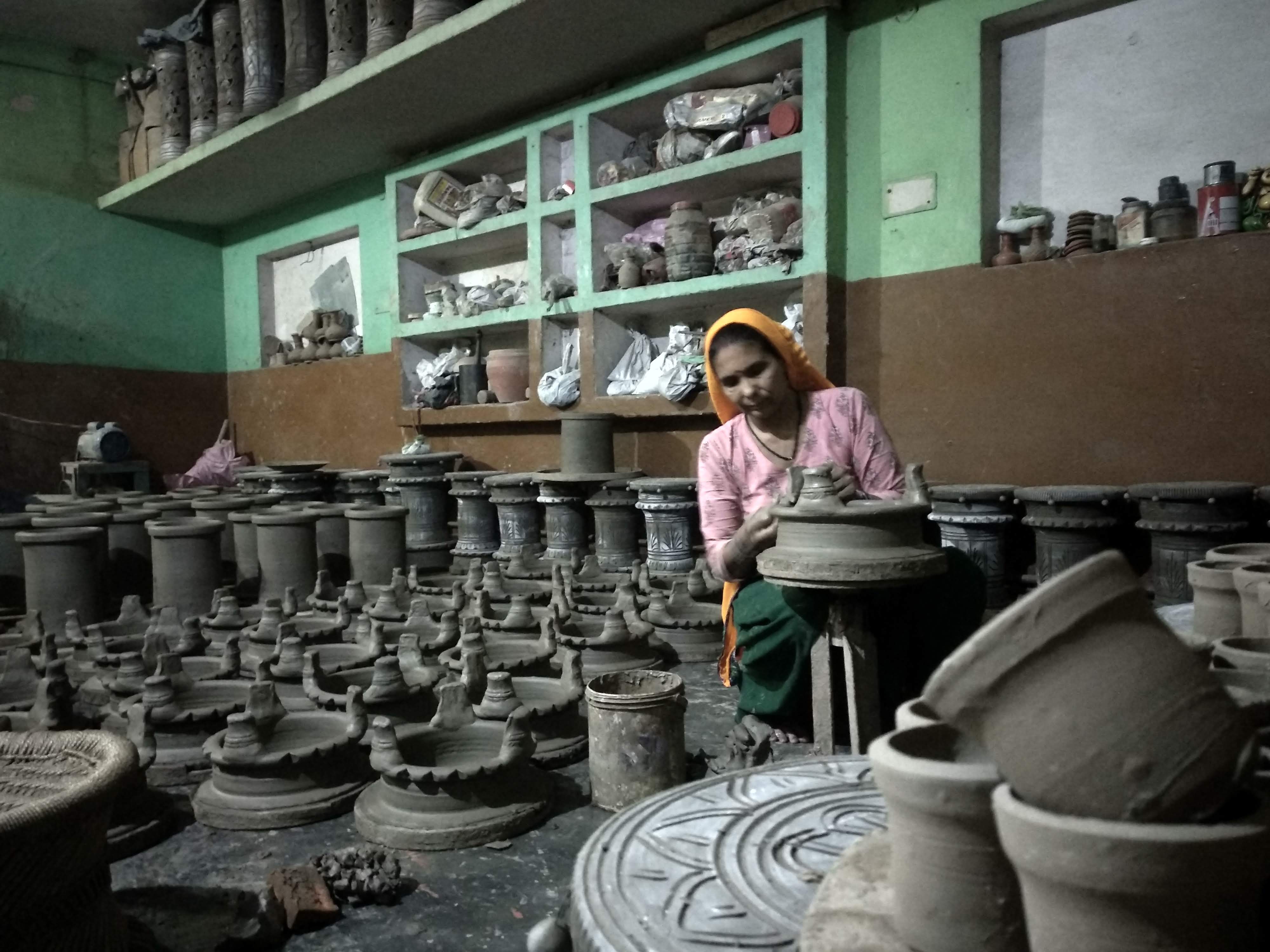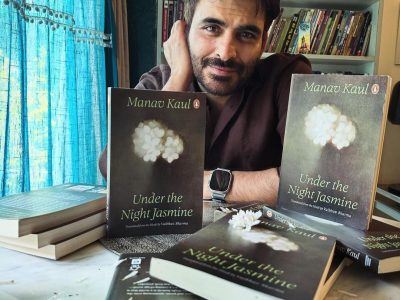Potters don’t believe that their furnaces are adding to the pollution in the city. But the NGT has asked the pollution control committee to demolish their means of livelihood
It’s business as usual at Kumhar Gram in Uttam Nagar, west Delhi. Some children are playing on the narrow streets and some are helping their parents at their shops. As one approaches any lane and looks up at the sky, fumes billow out from the kilns of many of these 500 houses.
Vimla (she uses her first name only), 50, is sitting in the middle of the large dimly lit room which is her workplace. She is making pots from wet clay with robotic precision. As we approach her and tell her about the tension which is simmering in this area, along with thick black smoke, she is startled.
The cause of tension is a directive by the Delhi Pollution Control Committee (DPCC) to demolish the furnaces running in Kumhar Gram, also known as Potter’s Village / Colony. The National Green Tribunal (NGT) directed the DPCC in April this year to submit an action-taken report in a case regarding the air pollution from the houses in this area.
When Vimla is told about the directive, she ridicules the order, saying, “Why don’t they first focus on traffic and other factors contributing to air pollution in the city? Once I was on a scooter behind one of those red DTC buses. Black smoke was coming out and the intensity of the heat shocked me. I’m sure these buses must be creating a lot of air pollution. Are the authorities aware of their impact on the environment?” she asks.

She also gives the example of crematoriums. “Wood is used to burn dead bodies even today, when there’s an alternative electric way of doing it. Why don’t they ban that also?” asks Vimla.
As for her own occupation, she claims, “Burning of wood for occupational purposes has been a practice passed down through generations. Hardly anyone has died due to inhaling these fumes. This area doesn’t have any mosquitoes, which have killed so many people in the city. We are safe from mosquitos because of these fumes,” says Vimla, a claim which most people who have stayed in villages will confirm.
“You go and check the nearby hospitals around our homes,” she carries on. “Ask them how many cases of dengue they have treated. The number will be very low. Wherever potters live, the risk of these diseases is eliminated. This has been the case since decades now.”
She gives an example of the older generation living in the area. “One of them who has touched the 100-year mark is doing absolutely fine. Even our children, have not faced any serious medical condition. They’re also inhaling the same smoke as us,” she claims.
Pointing to the fumes coming out of her own kiln, she claims, “It’s all from wood and wood powder. It’s not damaging any environment. Just to be on the safe side, I’ve also got a filter which we’ve installed over the furnace. It doesn’t let the fumes escape,” says Vimla.
Vimla says this age-old traditional occupation is an art which only a few of the family members have been able to learn, though every child born in the family is expected to learn it. Children “give a helping hand to the elders by shifting a pot from one place to another — so that they understand the delicate nature of these products. They develop a connection and keep these pots like their babies,” she explains.
She then jumps to the topic of after-birth medical waste and says, “In the past, we have even used this same powder to bury the waste. We put the waste which is generated after the birth of a baby in a gharha (pot) made by us and bury it somewhere. That’s the connection we have with wood and wood powder.”
Still hard at work, she opens up about the seasonal nature of the market for pots. “We are a family of 17 people. A significant part of our earning come in only twice a year — before summer and before Diwali. Don’t assume these are major profits. They just provide for the family’s daily expenses. We are doing this business because it’s a skill which we have learnt over the years and it’s the only thing we know. What will we do if they impose a ban on our business?” asks Vimla.
Outside, at every other corner, rising above balconies, the fumes blend into the air in no time. So how damaging are these fumes — to the people and the environment?
Vimla’s claims are seconded by Vikrant Tongad, an environment conservationist who works at a Delhi-NCR based NGO named — Social Action for Forest & Environment (SAFE). “I come from a rural background so I know enough to understand the work of the potters. We should first work on the major contributing factors to air pollution rather than killing off businesses of these potters,” says Tongad.
He was asked to give an estimate of the pollution caused to the environment if a potter bakes 100 pots. “It’s a rough estimate but one pot must be baked using not more than two cakes of cowdung. The emission caused by one cake of dung is equivalent to the smoke of two cigarettes. So the emission caused by 1,000 cigarettes is equal to the emission coming out from baking 100 pots,” he explains.
He says that the potters should be given an alternative means of livelihood if a ban is imposed. “What about the harm caused by so many tandoors to the environment and the istriwalas (those who press clothes using irons that burn coal)? They should also come under scrutiny of the authorities,” he says.
Chetram, a 30-year-old man, who has been learning pottery ever since his childhood, has no idea about the authorities’ order. His home too, is filled with a plethora of pots, leaving hardly any space to walk. Preparations are going on for the festive Diwali season.

“Why don’t they do one thing? Take each one of us to a hospital, get our lungs checked. Then they will know how damaging our business is to public health,” suggests Chetram.
“We are only burning wood powder. How much pollution does it add to the environment? We don’t cough even when we’re baking the pots, inhaling all that smoke. We only cough due to bad weather,” he quips.
While Vimla claims that the colony is mosquito-free, Chetram thinks otherwise. “Mosquitos can be found in the area but if they’re not dying from these fumes, how will the humans?” he asks.
With a family of 14 members, of whom five are children, Chetram’s year-round worry is finances. “We get work only for six to seven months. Whatever we earn during that period is just to sustain our household. After paying for many things, how will we even make any profit?” Chetram asks.
He explains that in order to sell these pots on the main road, a mini-truck is hired, for which the charge is anywhere between Rs 1,200 and Rs 1,500 for one round. On top of that, he claims, “The police also take some Rs 1,500 for letting us sell the pots on the streets for 10 days or so.”
Due to this non-profitable business, Chetram’s family is focusing more on the education of children in the household, than teaching them pottery. “At least they’ll be able to make some substantial income if they are educated — unlike us, who are making pots because it’s the only thing we know,” he concludes.
So if the NGT is serious about destroying pottery kilns, it should also provide an alternative means of livelihood for these self-employed traditional potters.





